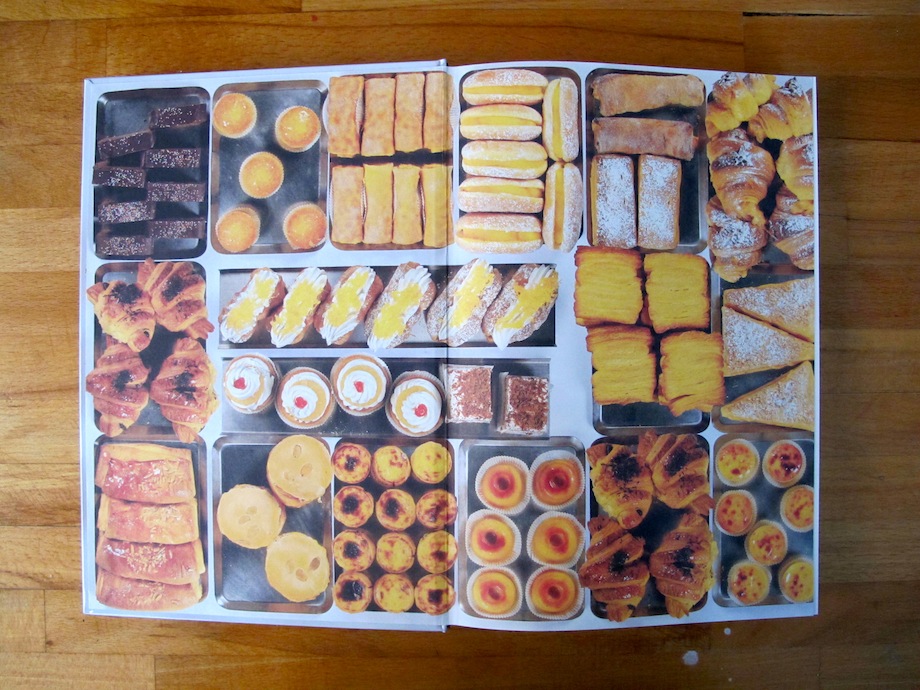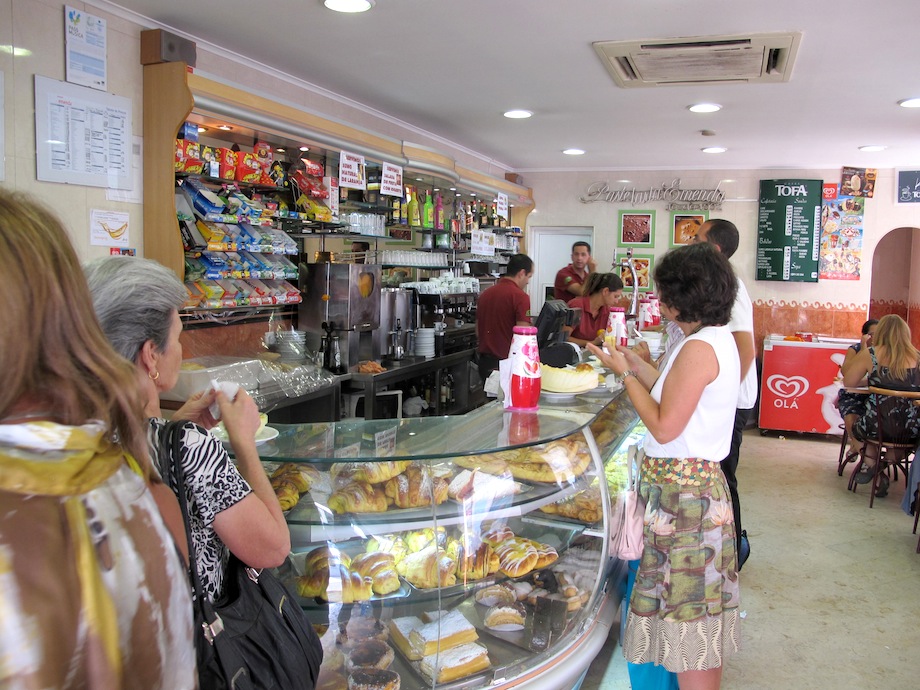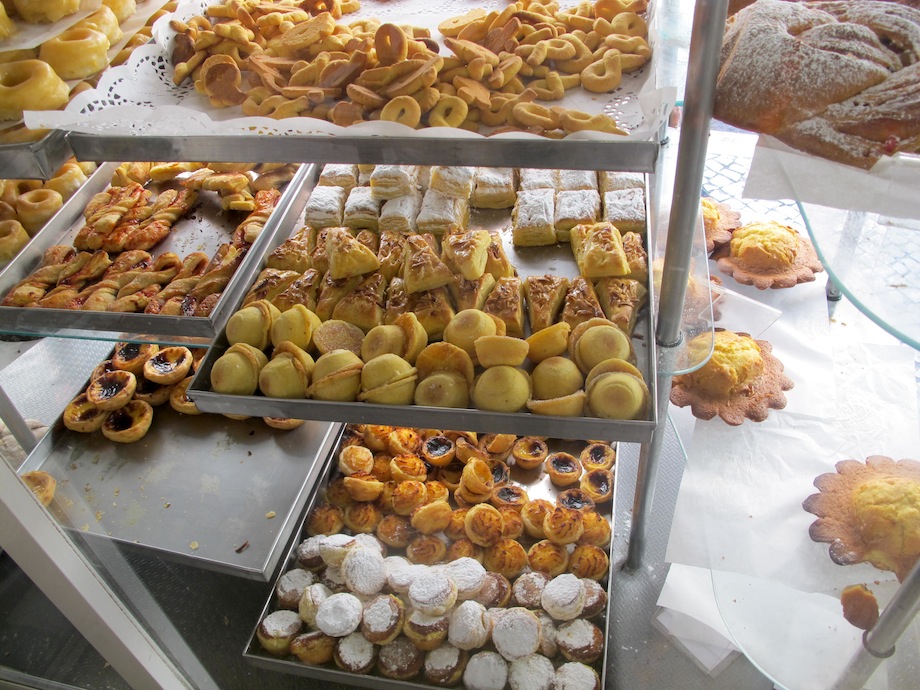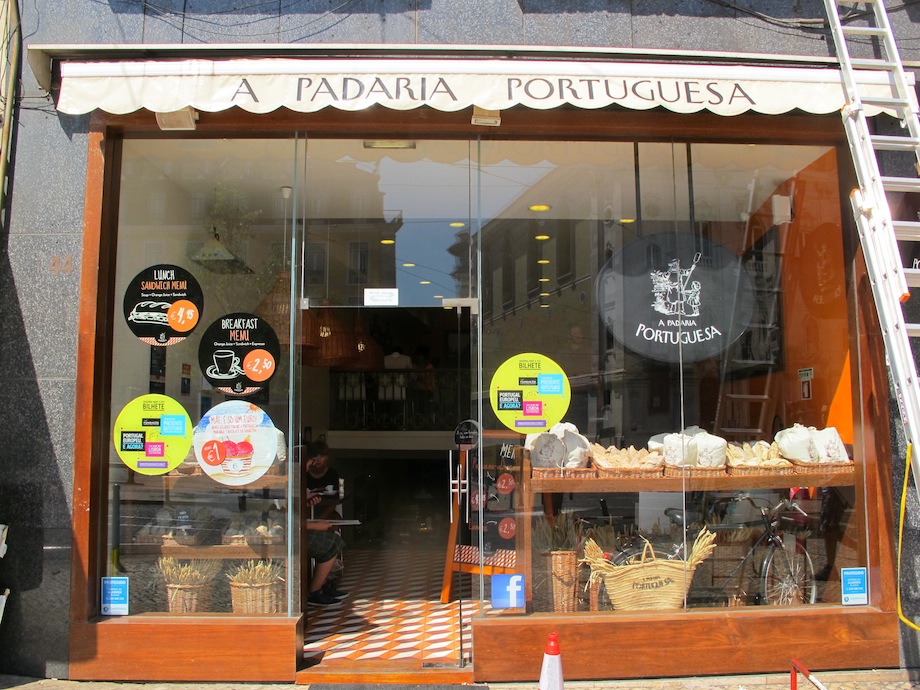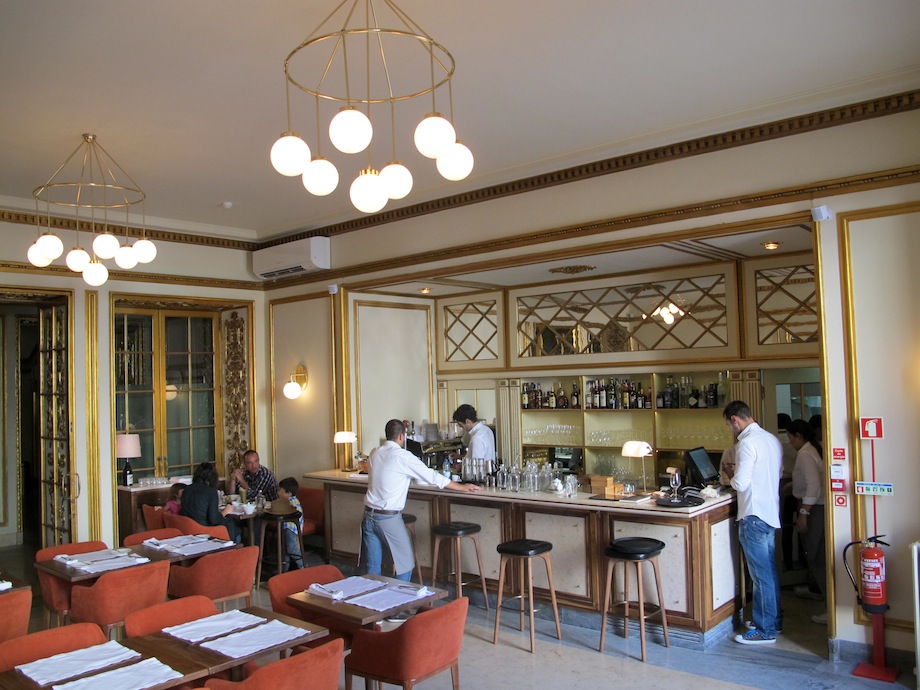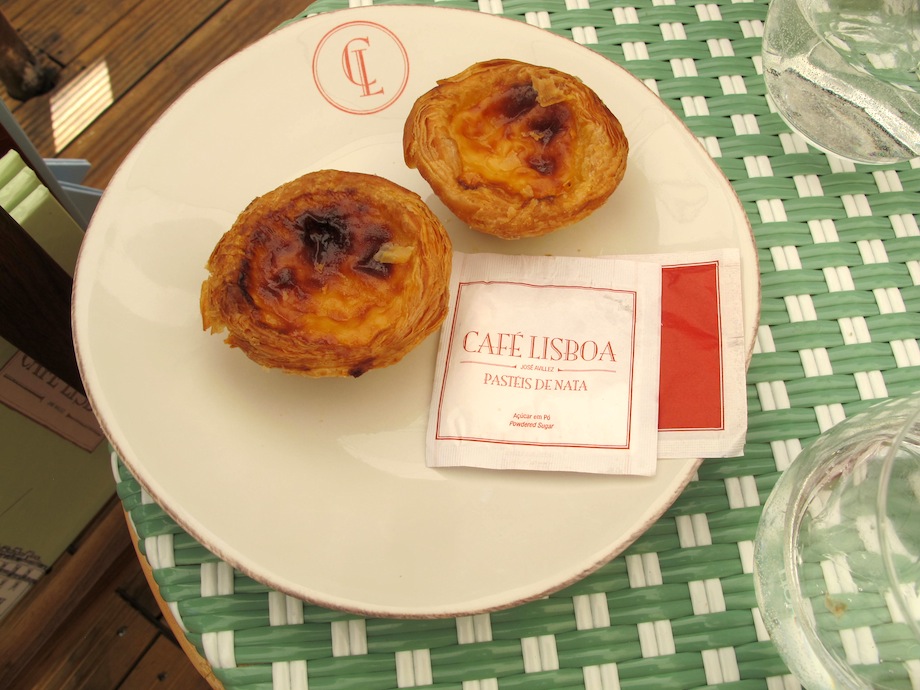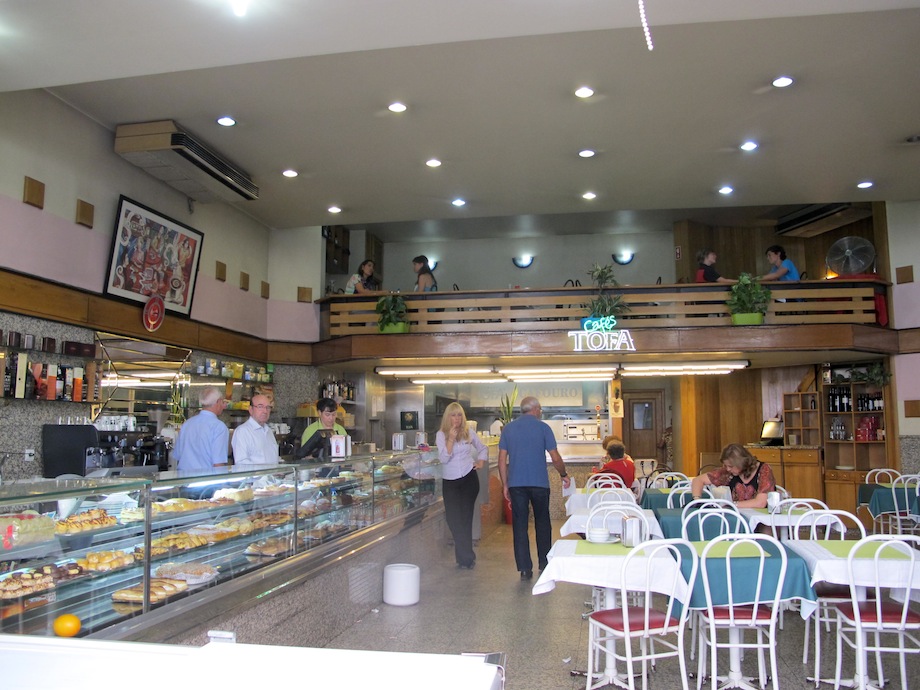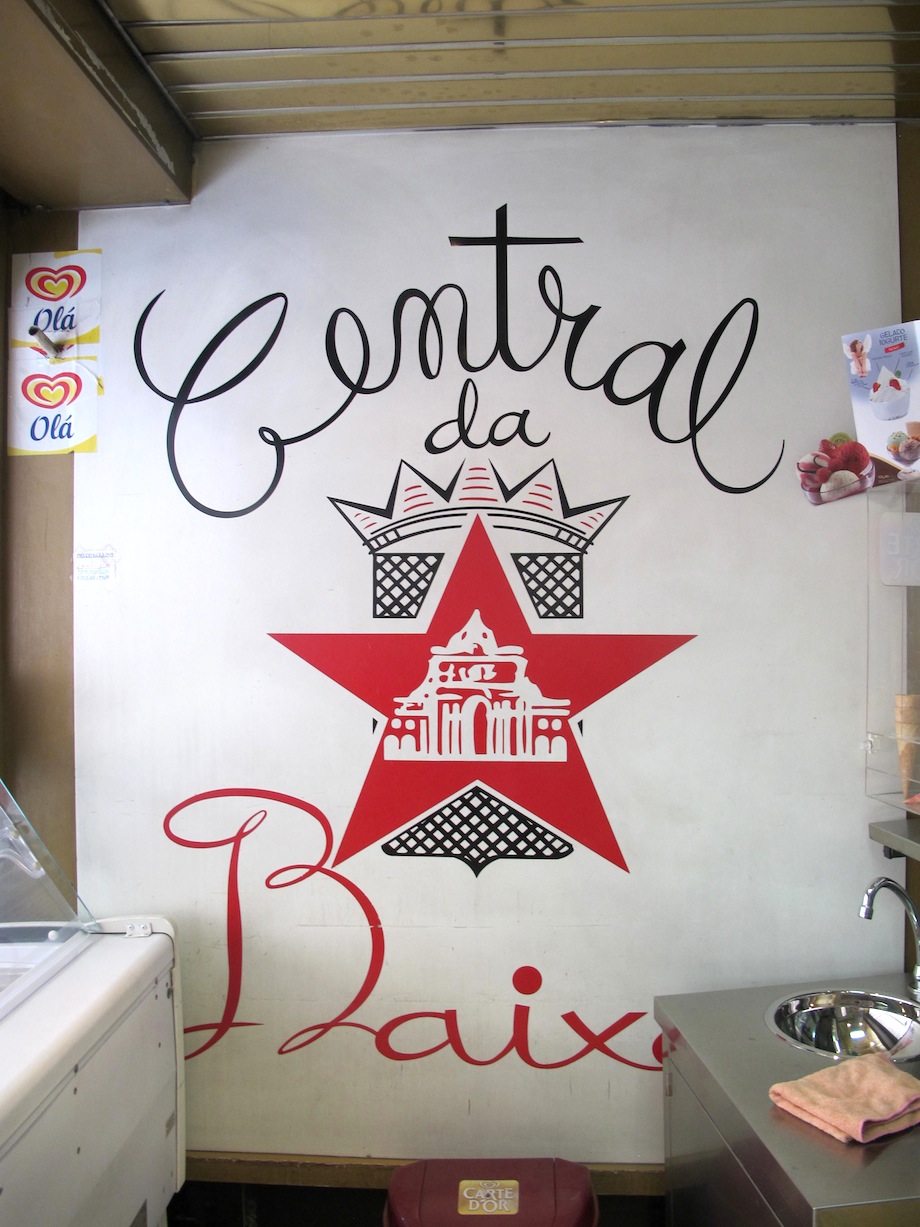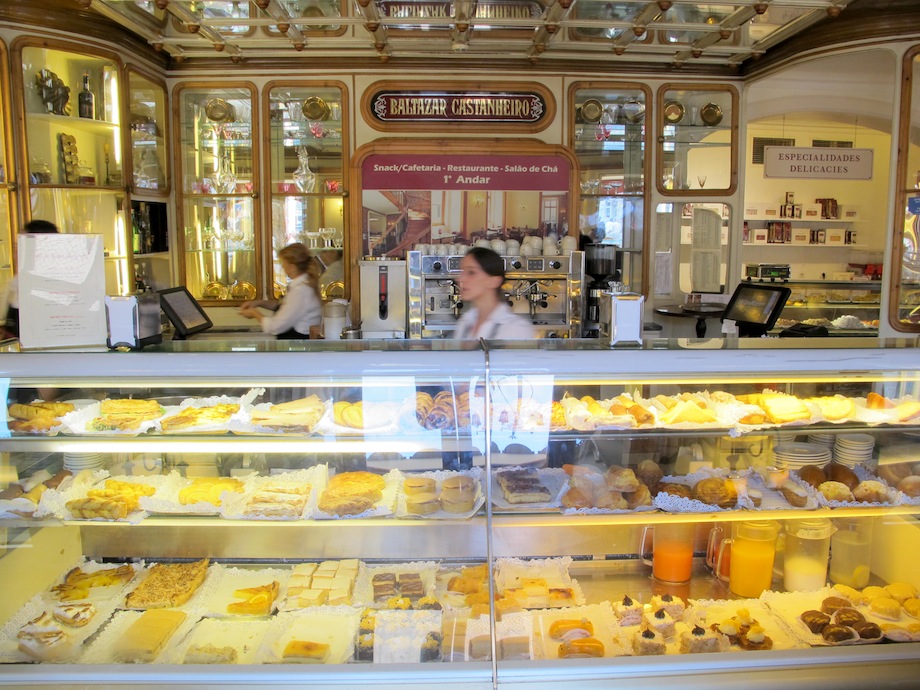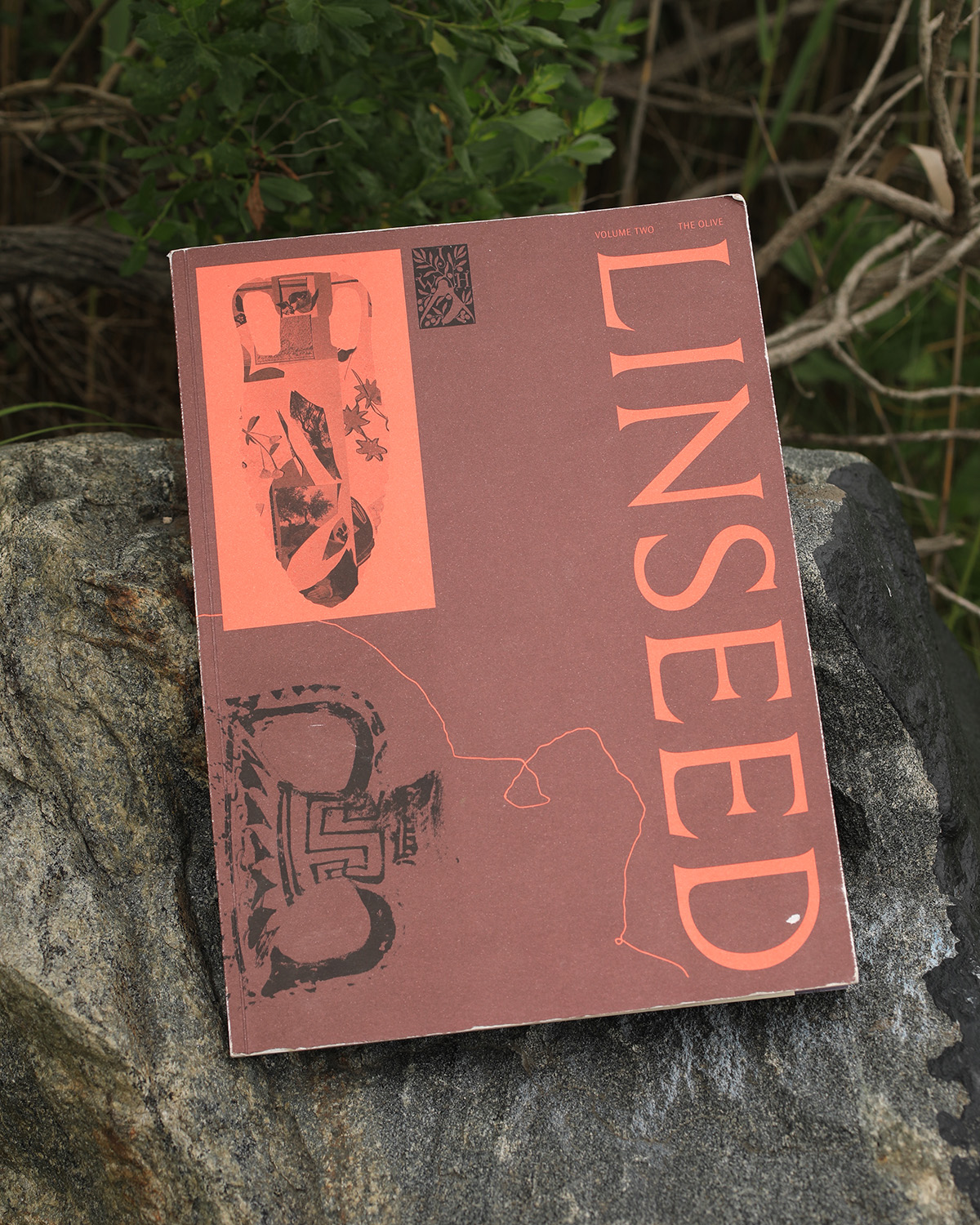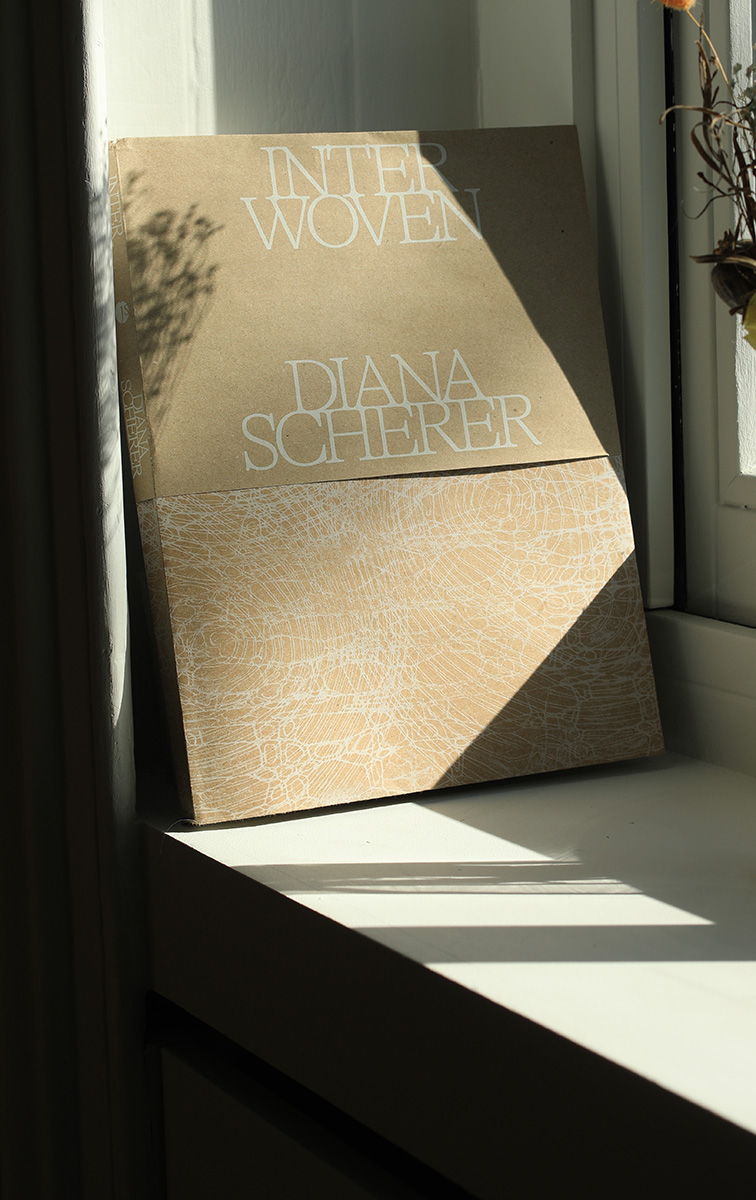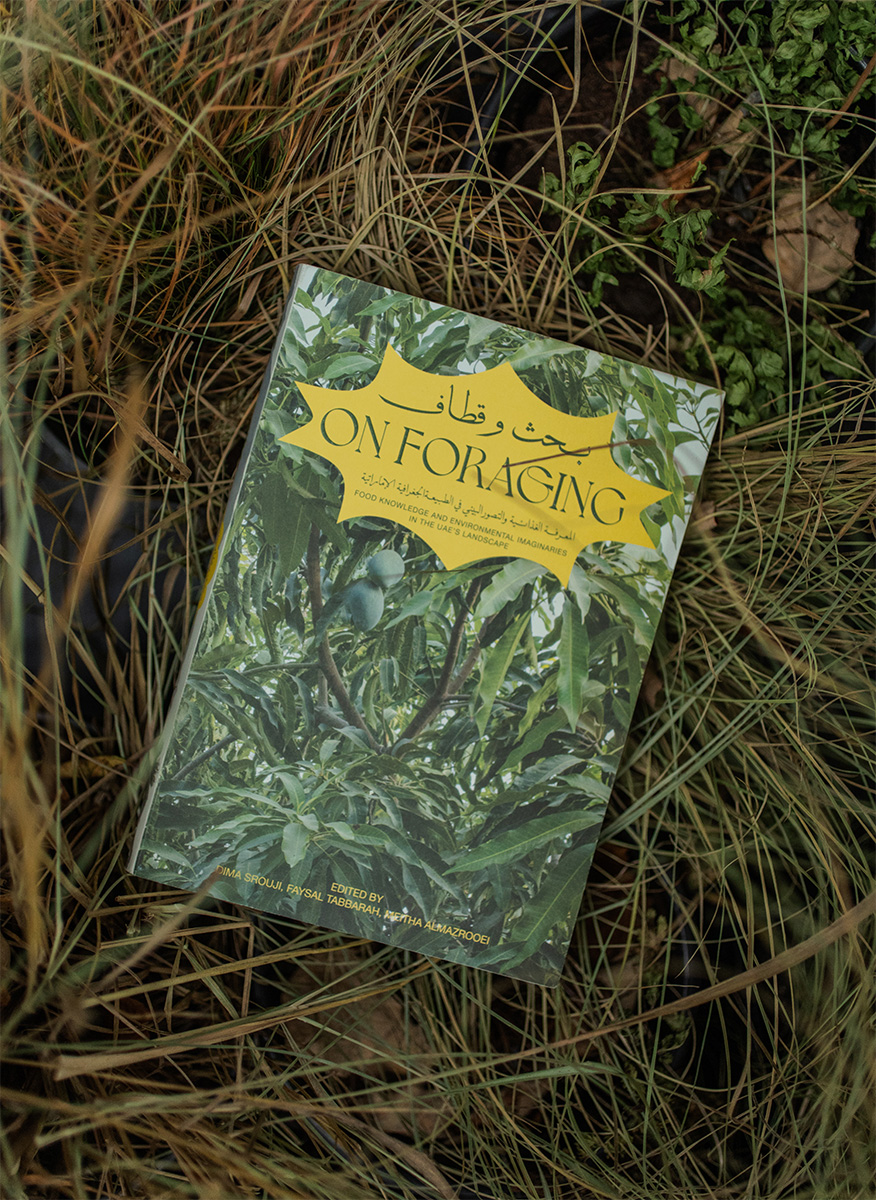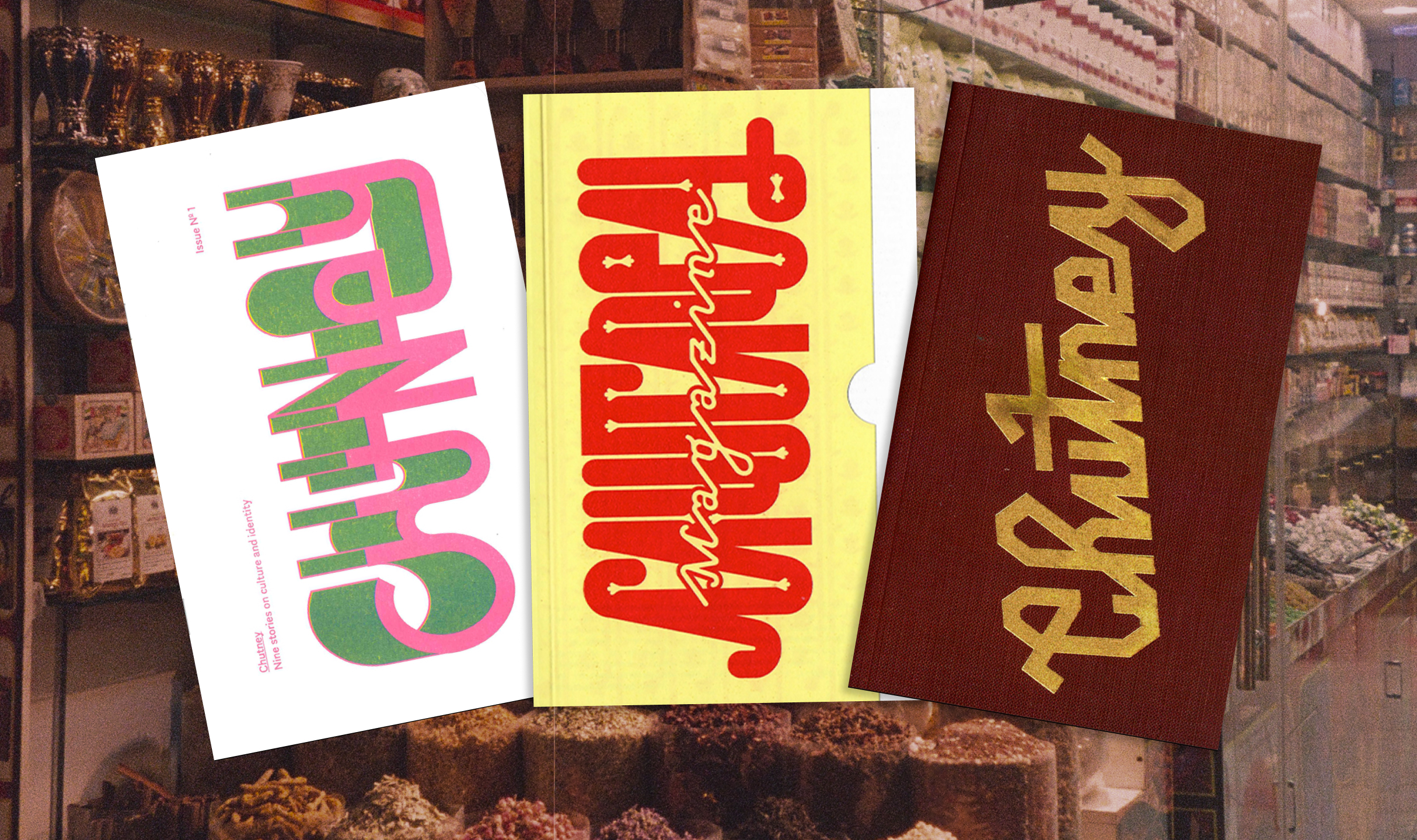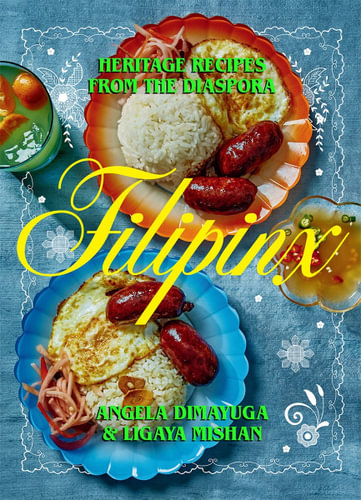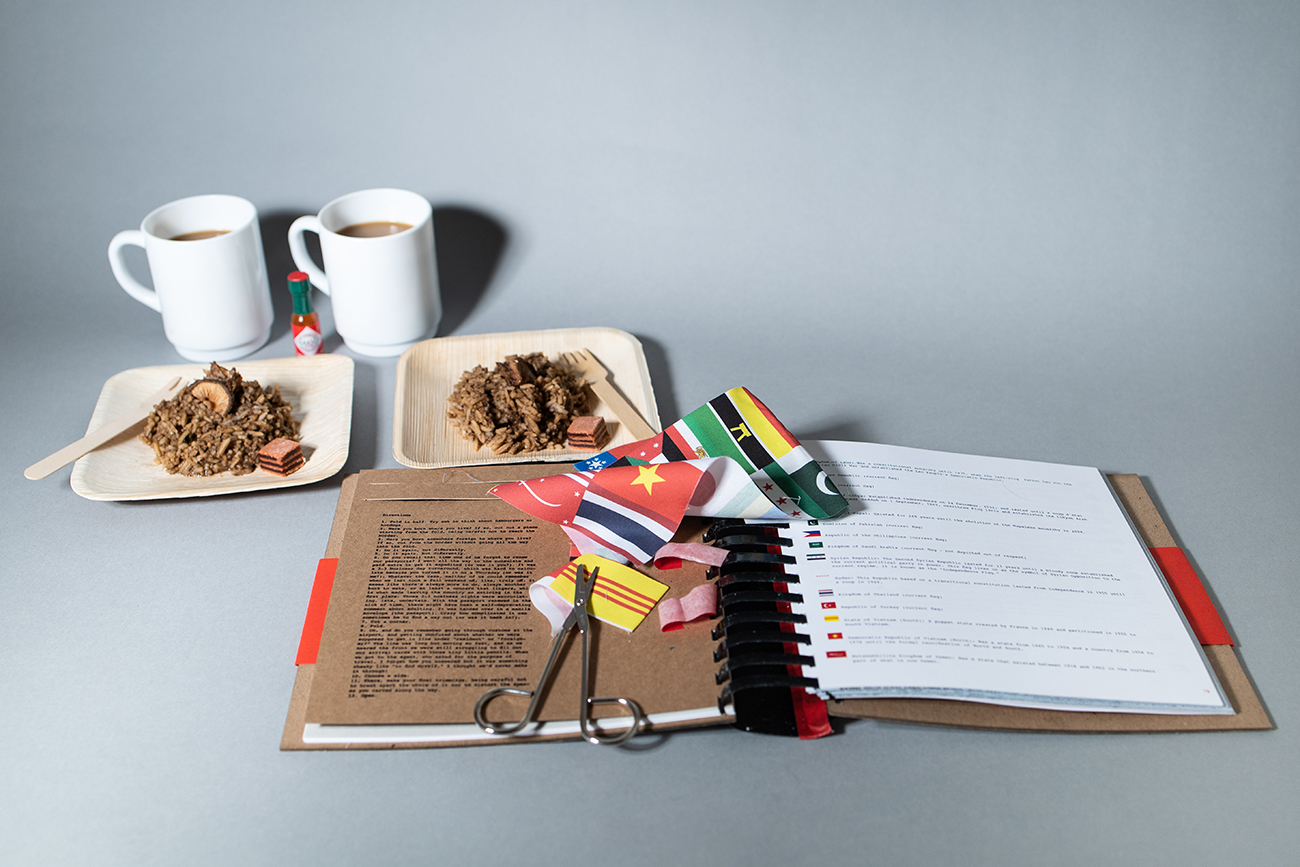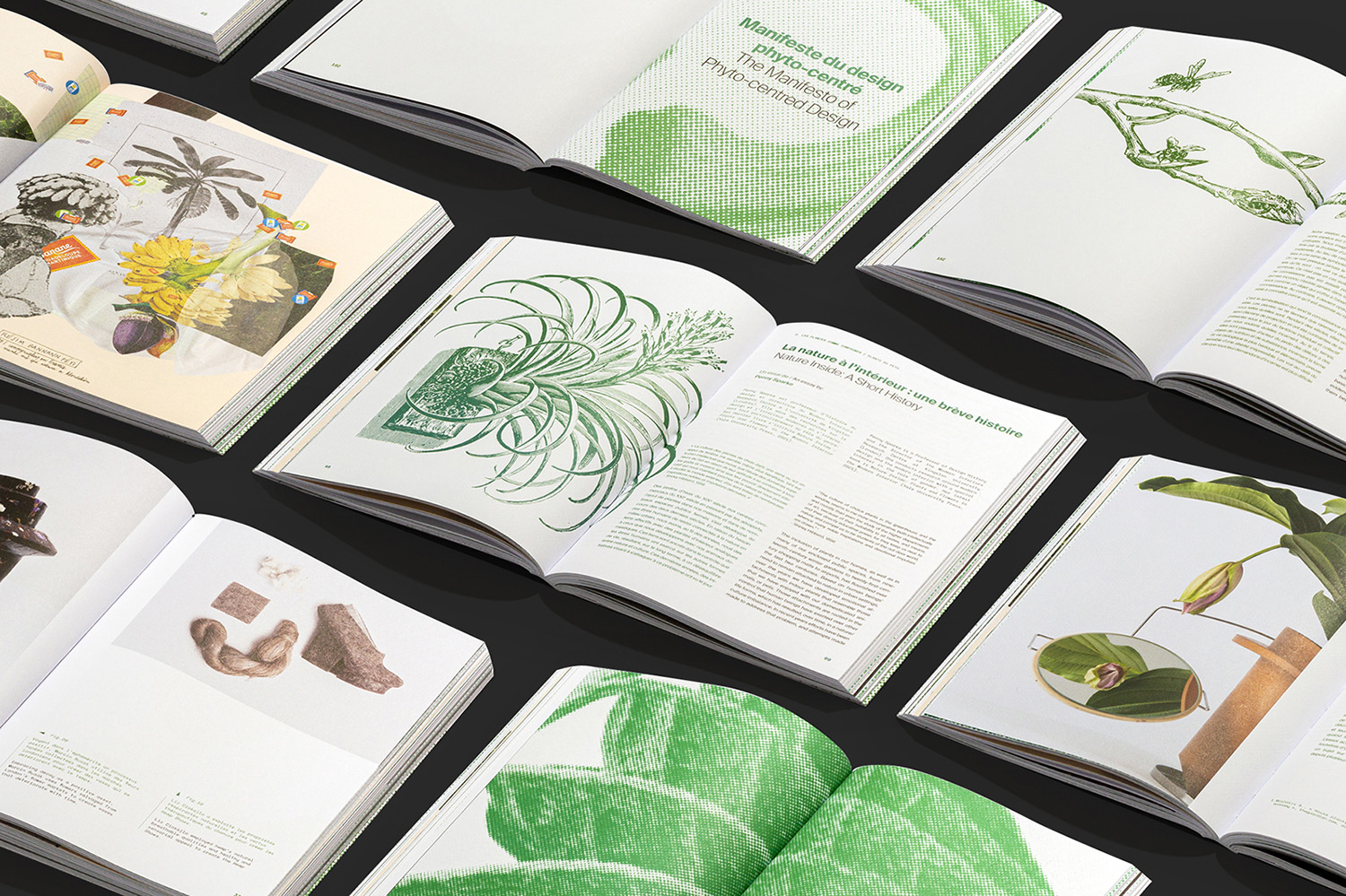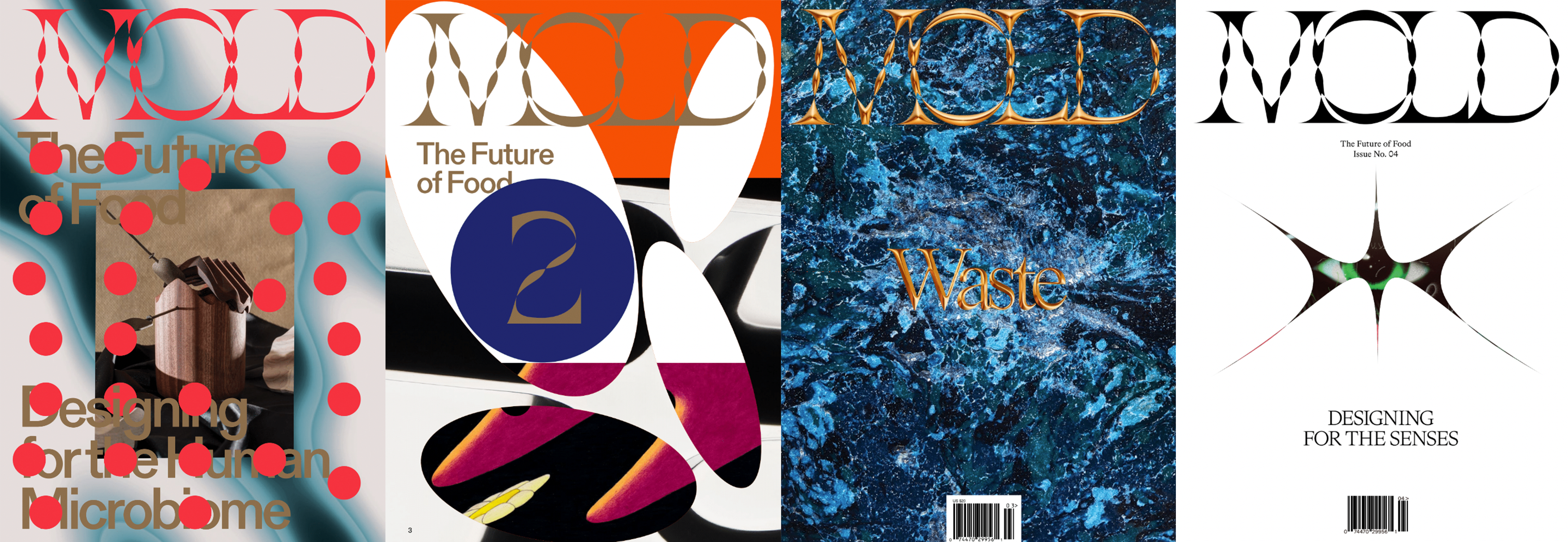Bakeries in Lisbon are as ubiquitous as corner stores in New York City. A unique culture, cast of characters and flow of activity gives each bakery a personality—from fresh squeezed orange juice in the morning to a lunch of soup and a pastry at the standing counter—the ebb and flow of people throughout the day for a sweet snack, a pack of gum or an espresso has its own distinct rhythm. I meet the design writer Frederico Duarte at a nondescript bakery in Lisbon’s Chiado neighborhood. He has kindly offered to give me a walking tour of a few Portuguese pastelaria and introduce some of the design nuances and histories of these “semi-industrial confectionaries.”
Duarte, along with co-collaborators Rita João and Pedro Ferreira, authored the wonderful Fabrico Próprio: The Design of Portuguese Semi-industrial Confectionery. Fabrico is a love letter to the Portuguese tradition of baked goods. Design essays, photo spreads and hand-drawn illustrations pepper the book, giving it the feeling of a wonderfully robust journal. As the introduction explains:
A confectionery cake is a consumer product like any other. A product conceived and made taking into account elements such as ingredients/components, form (content and container) and finishing/decoration…As such, all these elements that make this ‘product-cake’ are part of the process governing its manufacture. This process is by all accounts similar to the design process, the so-called ‘design methodology’.
The Fabrico Próprio “cake encyclopedia” documents five different types of dough and 92 pastries by ingredients, structure and history. “It’s a miracle if you think about it,” Frederico shared. “Even small bakeries make all of these pastries every single day. And it’s only possible because of the ingredients, machines and the efficiency of the processes.”
Follow along as Frederico explains some of the finer points of the culture and production behind Portugal’s beloved pastries below.
And for those readers in Berlin, you can join Frederico, Rita and Pedro for their book launch at Paz D’Alma.
Friday, November 22, 2013
19h
Paz D’Alma
Linienstrasse 121
10557 Berlin
PASTELARIA EMENDA
The interesting thing about this place is that it is unremarkable in the way it looks but it’s been here since 1932. A unique pastry at Pastelaria Emenda is their mega version of queue, an alliteration of the word cake.
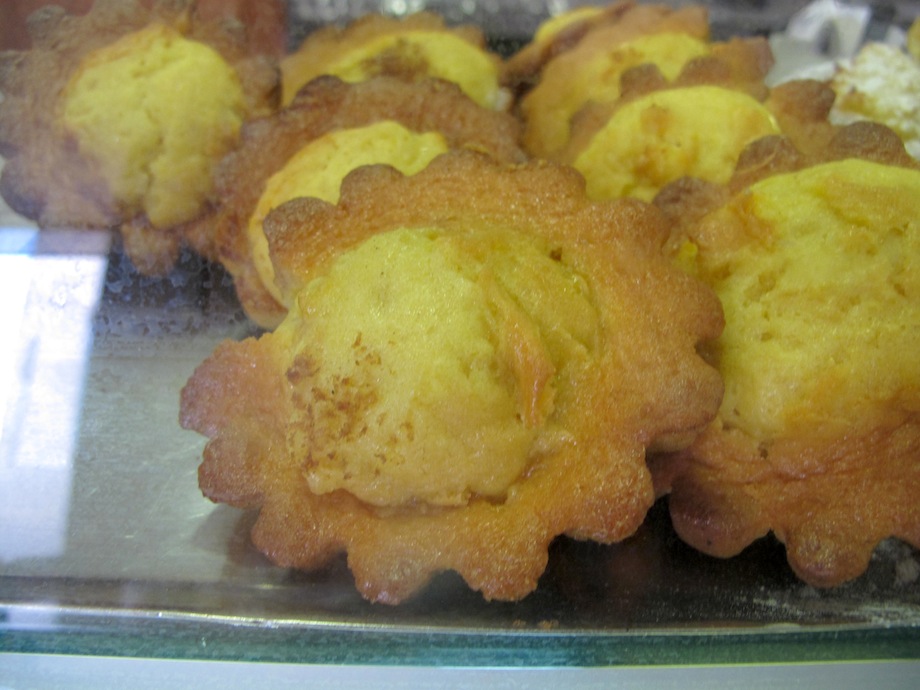 Queque dough is like a pound cake—yeast, dough and fat—and it’s supposed to be shaped like a crown. But every kid will call this cake, “little titties” and eat the “nipple” first. Even though a grandmother might let a kid have queue because it is nice and dry (without cream), it’s actually one of the fattiest pastries. We feature the queue gigante in one section of our book, Rare Species. We commissioned an illustrator to create archaeological drawings and this particular cake is notable for its size.
Queque dough is like a pound cake—yeast, dough and fat—and it’s supposed to be shaped like a crown. But every kid will call this cake, “little titties” and eat the “nipple” first. Even though a grandmother might let a kid have queue because it is nice and dry (without cream), it’s actually one of the fattiest pastries. We feature the queue gigante in one section of our book, Rare Species. We commissioned an illustrator to create archaeological drawings and this particular cake is notable for its size.
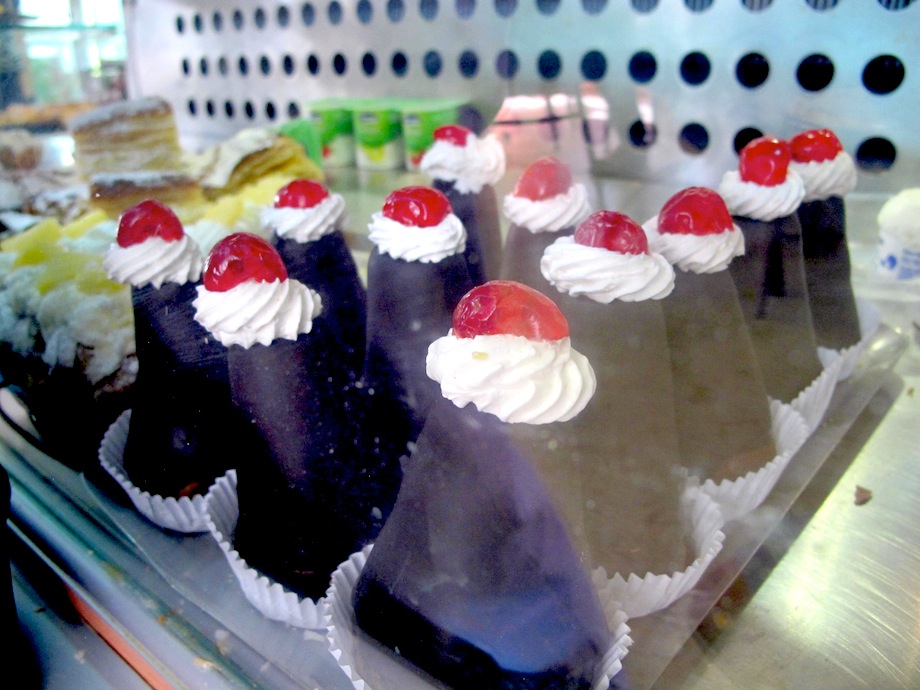 The pyramid is actually what started our project. We call it the “cake of cakes” because there’s a myth that it’s made out of the leftovers of other cakes. This is partially true because the pyramid is actually made from the trimmings of the other cakes. When the baker cuts and prepares all these cakes, the trimmings are thrown in a bowl, sugar is usually added and then it’s shaped into this amorphous form and coated in chocolate with whipped cream, sugar and a cherry on top. It’s called a pyramid but it’s actually a cone. For the first article we wrote on the design of cakes, we photographed pyramid cakes and then cut them in half for a cross-section—they are totally different on the inside depending on the trimmings used. For example, during Christmas, there are a lot of nuts and remnants of leftovers of king cake (galete de voire, a french cake.) It’s the kind of cake that your mother would never let you eat.
The pyramid is actually what started our project. We call it the “cake of cakes” because there’s a myth that it’s made out of the leftovers of other cakes. This is partially true because the pyramid is actually made from the trimmings of the other cakes. When the baker cuts and prepares all these cakes, the trimmings are thrown in a bowl, sugar is usually added and then it’s shaped into this amorphous form and coated in chocolate with whipped cream, sugar and a cherry on top. It’s called a pyramid but it’s actually a cone. For the first article we wrote on the design of cakes, we photographed pyramid cakes and then cut them in half for a cross-section—they are totally different on the inside depending on the trimmings used. For example, during Christmas, there are a lot of nuts and remnants of leftovers of king cake (galete de voire, a french cake.) It’s the kind of cake that your mother would never let you eat.
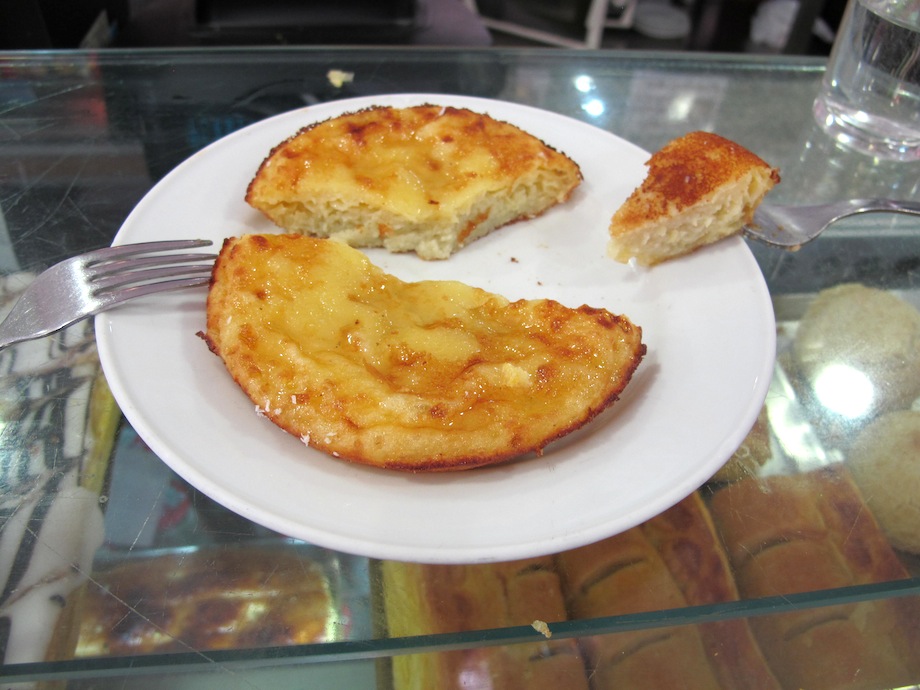 This one is the tigelada, and it’s usually made in a terracotta bowl. Tigelada is mainly egg and sugar it’s one example of the confectionery that came from the convents during the Age of Discovery during the 15th and 16th century. It was a perfect storm for Portugal. We had sugar and a lot of spices—namely cinnamon and coconut. During that time, many dowrys or donations to the church were paid in sugar. Portugal’s colonies—first in Madeira, then Cape Verde and then Brazil—were producing huge amounts of sugar, Europe’s main cash crop. Some scholars say the whole enterprise of the age of discovery was the search for sugar.
This one is the tigelada, and it’s usually made in a terracotta bowl. Tigelada is mainly egg and sugar it’s one example of the confectionery that came from the convents during the Age of Discovery during the 15th and 16th century. It was a perfect storm for Portugal. We had sugar and a lot of spices—namely cinnamon and coconut. During that time, many dowrys or donations to the church were paid in sugar. Portugal’s colonies—first in Madeira, then Cape Verde and then Brazil—were producing huge amounts of sugar, Europe’s main cash crop. Some scholars say the whole enterprise of the age of discovery was the search for sugar.
Many of the convents worked as small manufacturing units and even small cities. During Lent, you couldn’t use eggs—for 40 days and 40 nights—but the chickens would still be laying eggs. So many of the more eggy treats, sweets and confections are made during Easter when the convents had eggs in abundance. The whites are used for starch or other things and these pastries are a sort of byproduct using the egg yolks. A lot of the more traditional egg and cream pastries are a result of young women with a lot of eggs, sugar and time.
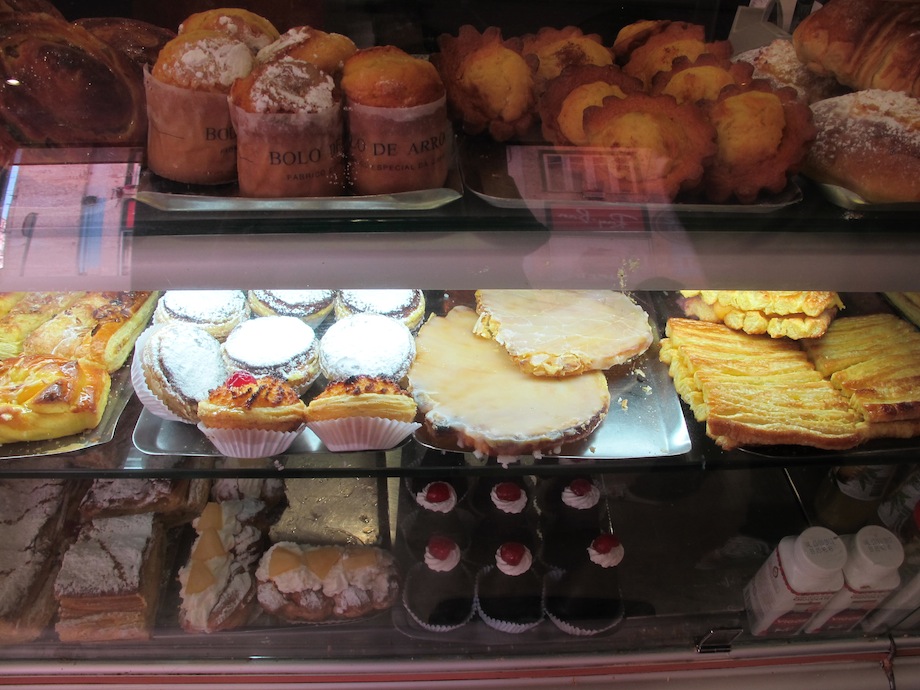 The bottom shelf has the pastries with cream because it is usually the coldest shelf. You notice that the pastry trays are uniform throughout all of these bakeries as well.
The bottom shelf has the pastries with cream because it is usually the coldest shelf. You notice that the pastry trays are uniform throughout all of these bakeries as well.
A PADARIA PORTUGUESA
This is the first chain bakery selling Portuguese pastries. It just opened 3 or 4 years ago but the chain has grown quickly and they’ve expanded into key areas of Lisbon.
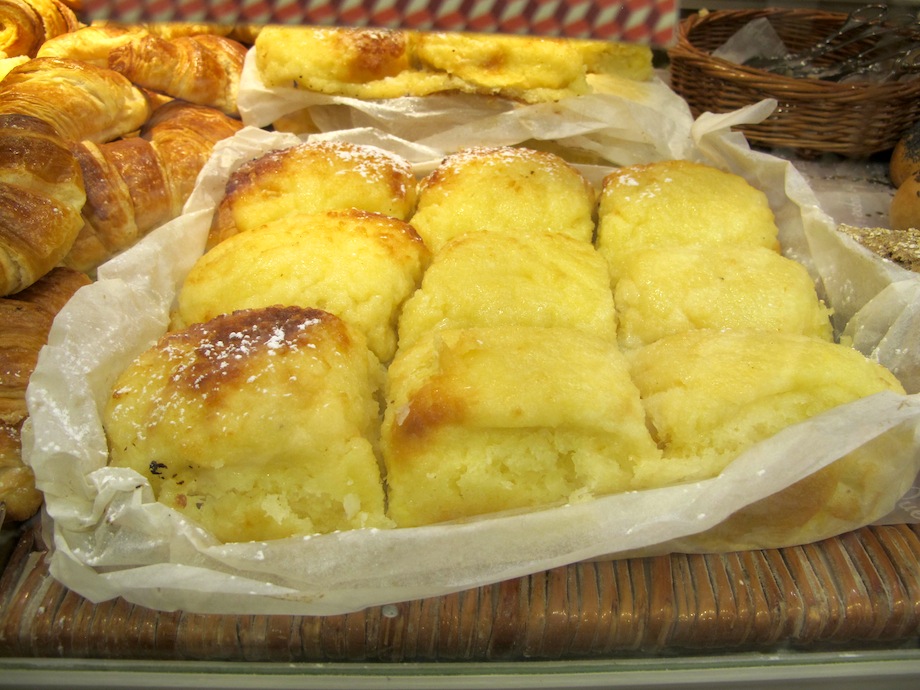 When they opened, the main attraction was the Pao de Deus—a brioche with coconut paste. Their version has significantly more coconut on top—it’s basically a lump of coconut paste on a smaller brioche.
When they opened, the main attraction was the Pao de Deus—a brioche with coconut paste. Their version has significantly more coconut on top—it’s basically a lump of coconut paste on a smaller brioche.
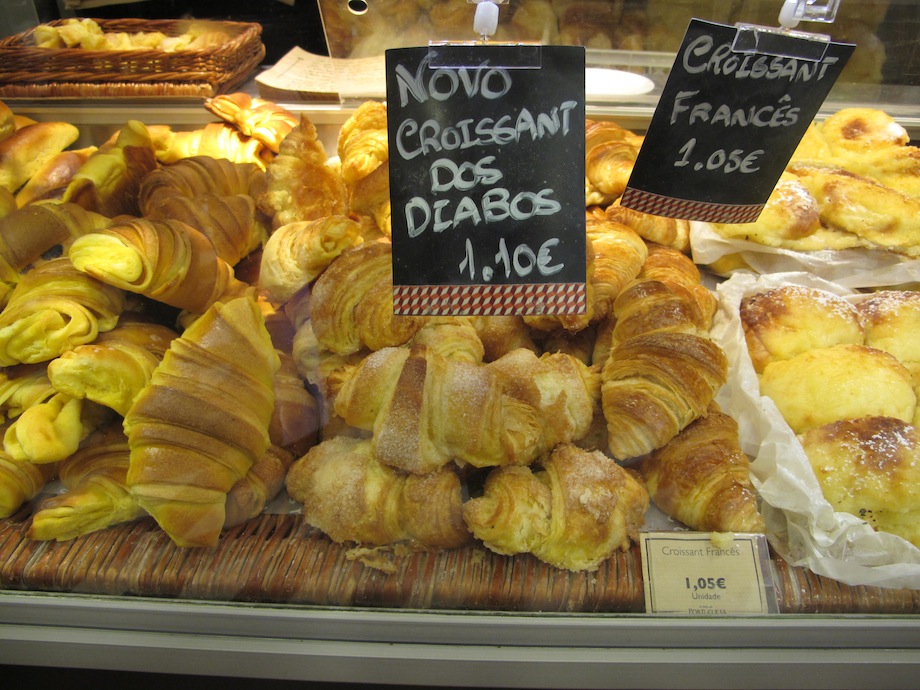 Recently, they introduced this new sugary brioche croissant. This kind of croissant is more popular in the north, in Porto.
Recently, they introduced this new sugary brioche croissant. This kind of croissant is more popular in the north, in Porto.
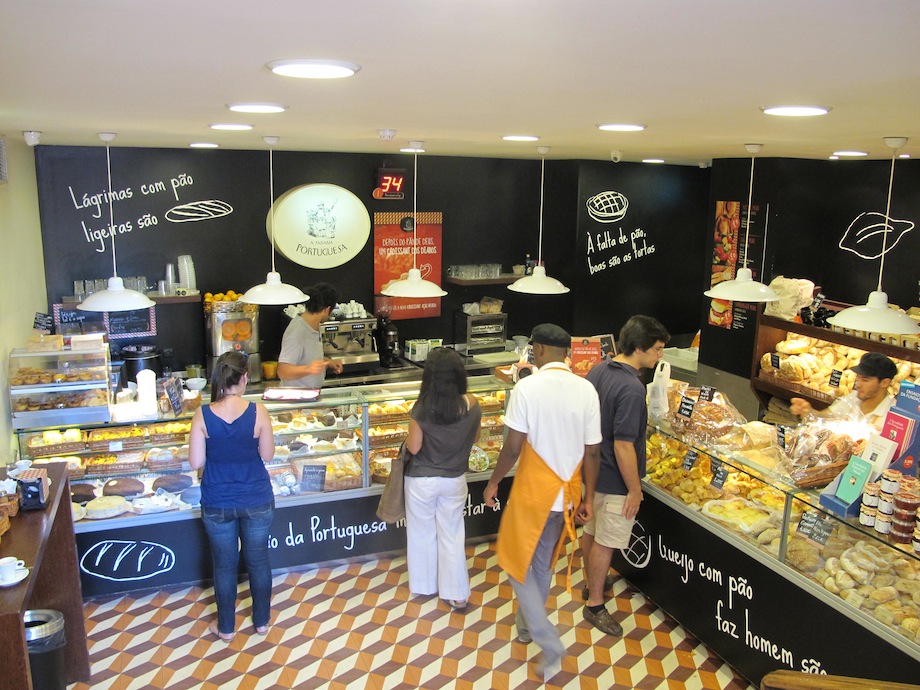 You can see how a simple idea like a pastelaria became a chain. But it’s the design of the experience which has made this chain especially popular. For example, the tiles used feel traditional and even the baskets here are a similar size and shape of the more traditional metal display trays. They have these ticket dispensers—used in busy traditional Portuguese bakeries—which you don’t really need here. Of course there is the efficiency. They probably bake some of their pastries in a central location and distribute them. They also sell a line of pre-packaged goods like cookies.
You can see how a simple idea like a pastelaria became a chain. But it’s the design of the experience which has made this chain especially popular. For example, the tiles used feel traditional and even the baskets here are a similar size and shape of the more traditional metal display trays. They have these ticket dispensers—used in busy traditional Portuguese bakeries—which you don’t really need here. Of course there is the efficiency. They probably bake some of their pastries in a central location and distribute them. They also sell a line of pre-packaged goods like cookies.
CAFE LISBOA
Editor’s Note: The popular, young, Michelin-starred chef José Avillez opened this old-world style cafe in Lisbon’s opera house, the Teatro Nacional de São Carlos. Enjoy a leisurely afternoon snack of pastel de nata, Portugal’s unofficial national treat, al fresco in the plaza of the theater. We stop in to try Avillez’s interpretation of the beloved egg custard tart.
We were invited to be part of the jury of an annual contest for the best pastel de nata in Lisbon. Rita was part of the jury. There were six jurors, and they had to eat 12 different tarts in 15 minutes. It was like a wine tasting where everyone has a bite and then you throw the rest away. There were different criteria: how it looks, the way the pastry felt, the way the cream was made. The same cafe, Pastelaria Aloma, won for the second time in the row. This year there was also some controversy because one of the contestants was the big supermarket chain Continente. They entered their own pastel de nata which you can buy at the supermarket. The interesting thing is that they came in second place in a blind tasting. You can make these anywhere, even at the scale of a supermarket chain.
That is something we always try to stress. These cakes are not meant to be made at home. That’s why we only have one recipe in our book. You have to rely on the fact that these are really complex ingredients and procedures.
PASTELARIA CAFOURE
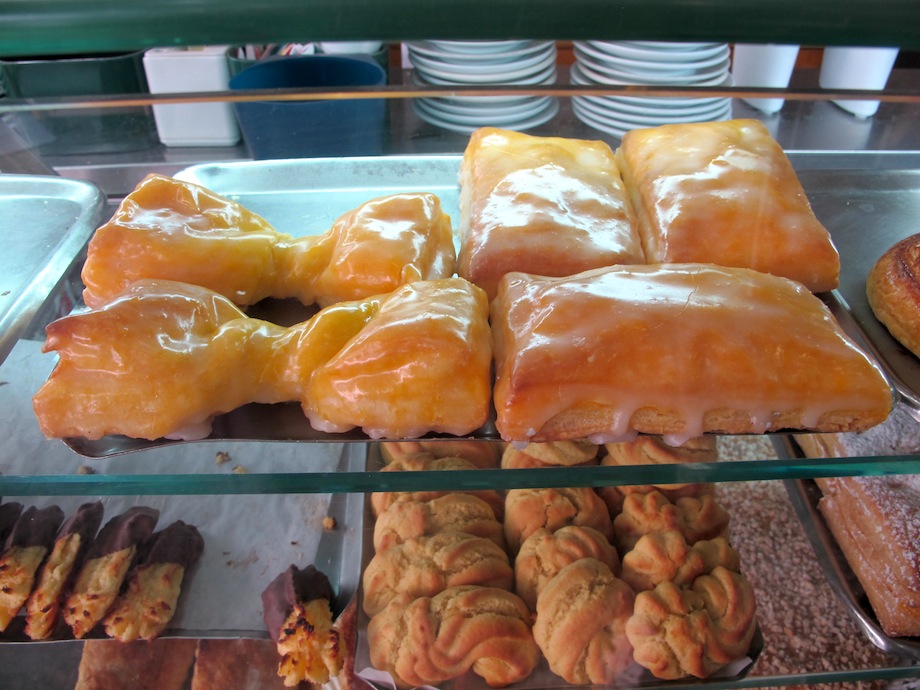 From the pages of Fabrico Próprio
From the pages of Fabrico Próprio
Laço (Bow)
Ingredients: Puff pastry dough, doce de ovos coating and sugar glaze.
History and Curiosities: A formal variation of the Brisa (below) achieved by twisting a rectangle of puff pastry dough twice, giving it its characteristic shape. It is occasionally possible to find variations sprinkled simply with cinnamon and sugar.
Brisa (Breeze)
Ingredients: Puff pastry dough, doce de ovos coating and sugar glaze.
History and Curiosities: Although often claimed to have originated in Leiria and derived from the regional specialty of Brisas do Lis , we do not find the two cakes sufficiently similar to justify the connection.
 From the pages of Fabrico Próprio
From the pages of Fabrico Próprio
Indiano (East Indian)
Ingredients: Two portions of Roulade and Napkin dough, joined with butter cream, finished with coffee or chocolate fondant icing.
History and Curiosities: Also known as the Geladinho (Icy) or Delicioso (Delicious). The butter cream in the coffee variation is also coffee-flavoured. Due to its high number of calories, it has become less common in pastry production and teaching.
CENTRAL DA BAIXA
Rare cakes are stranger variations of existing cakes. We have a whole chapter dedicated to this in the book with beautiful cake illustrations from Guida Casella, who specializes in medical and archaeological drawings. This place has at least two cakes that you can’t find anywhere else.
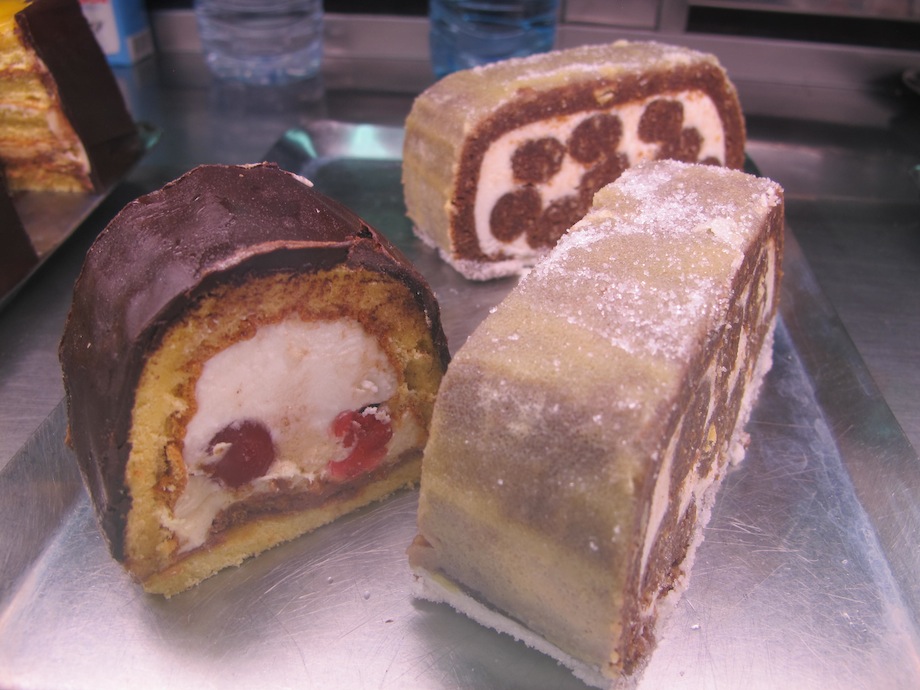 The Sabóia is made similarly to the pyramid—they use trimmings to make the rolls and the shell with a butter cream filling. In the ’40s the Sebóia was very popular but now, you can really only find it here in Lisbon.
The Sabóia is made similarly to the pyramid—they use trimmings to make the rolls and the shell with a butter cream filling. In the ’40s the Sebóia was very popular but now, you can really only find it here in Lisbon.
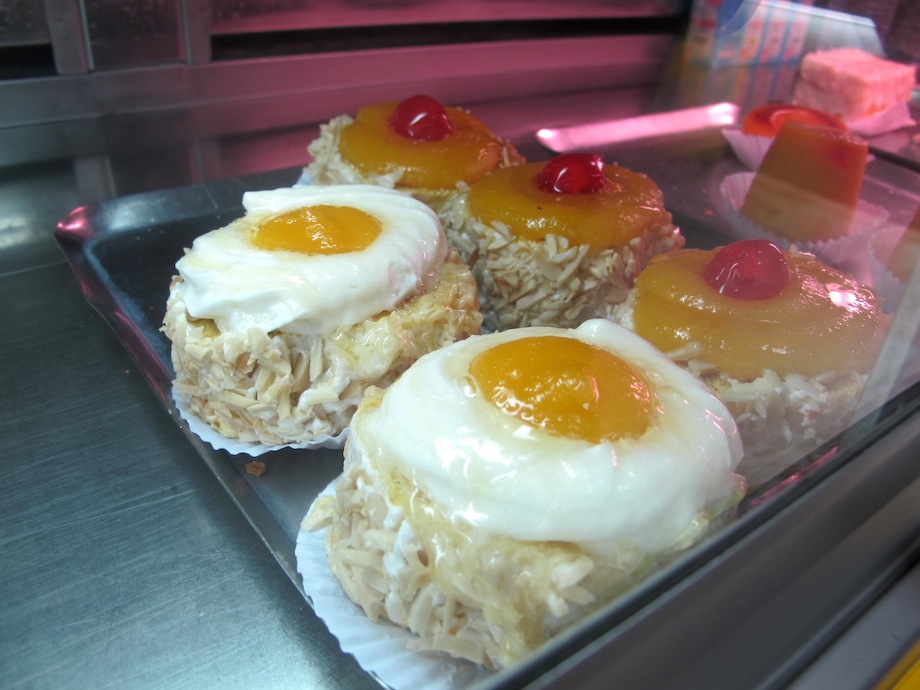 And this is the Ovo Estrelado or “fried egg.” It’s a spongecake with white buttercream on top and the yellow is doce de ovos , a mixture of egg yolks, water and sugar.
And this is the Ovo Estrelado or “fried egg.” It’s a spongecake with white buttercream on top and the yellow is doce de ovos , a mixture of egg yolks, water and sugar.
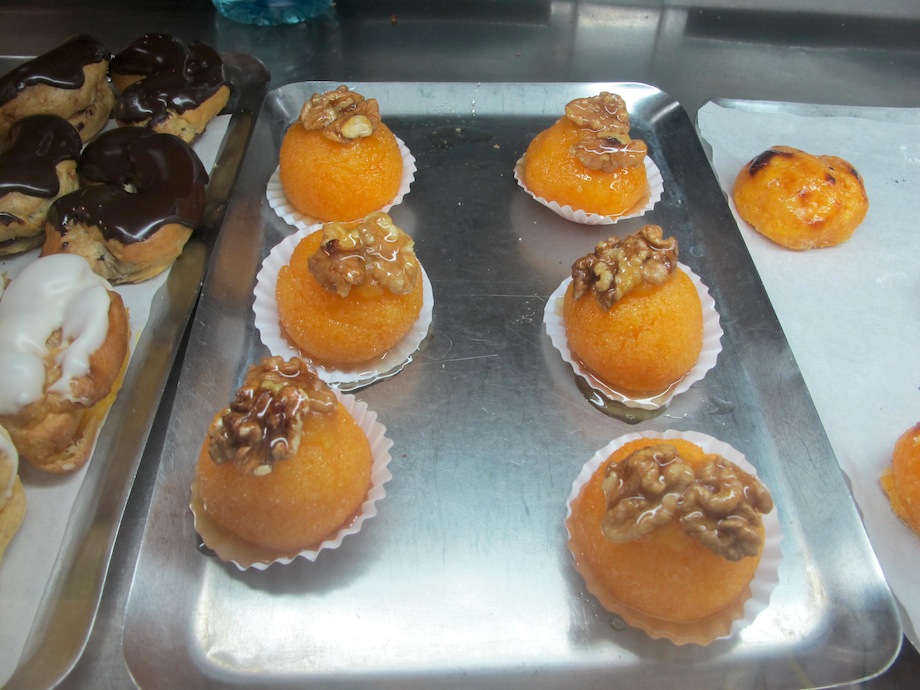 From the pages of Fabrico Próprio
From the pages of Fabrico Próprio
Noz (Walnut)
Ingredients: Egg Yolk, sugar and walnut.
History and Curiosities: Known as the Noz de Sintra or Noz de Cascais, its origin is disputed by these two towns near Lisbon. It is also claimed to be a cake popular with the moneyed elite residing in the Cascais area.
CONFEITARIA NACIONAL
It is perhaps the most feted about patisserie in Portugal. It has been around for two centuries (since 1829), and even so, it keeps the belief in the importance of space as a quality it uniquely upholds.
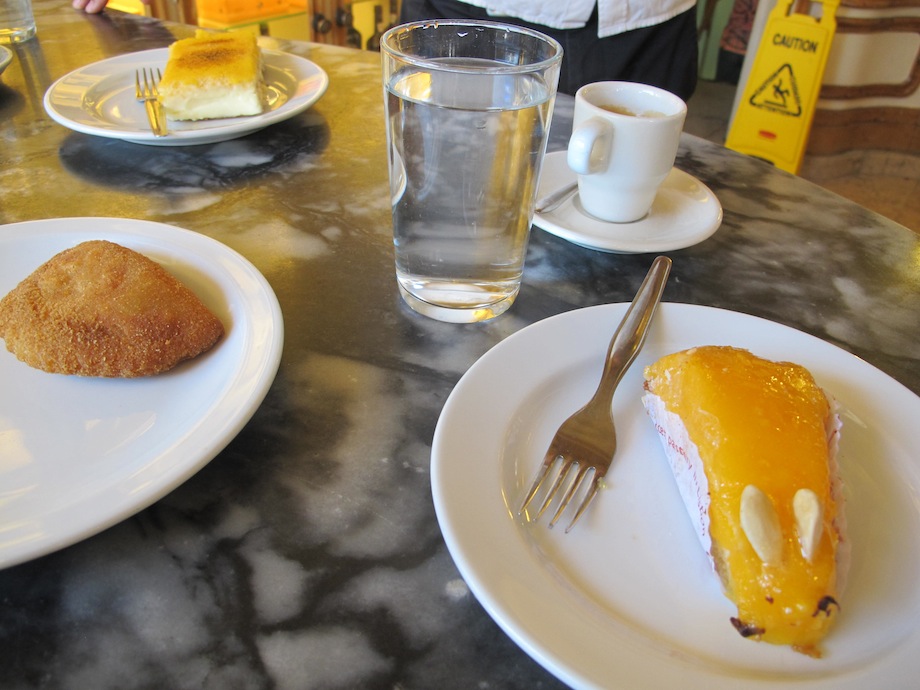 From the pages of Fabrico Próprio
From the pages of Fabrico Próprio
Coelhinho (on the right)
Ingredients: Sponge cake, chantilly cream, doce de ovos glaze, almond “ears” and chocolate “eyes.”
